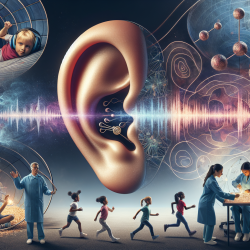Understanding Auditory Processing Disorders (APD) in Children
Auditory Processing Disorder (APD) affects approximately 2-5% of children, yet it remains a poorly understood condition. Children with APD often struggle to understand speech in noisy environments, despite having normal hearing abilities. This blog explores the findings from a recent study on medial efferent mechanisms and their potential role in APD, providing insights for practitioners seeking to improve outcomes for affected children.
The Role of Medial Efferent Mechanisms
The medial olivocochlear (MOC) system, part of the efferent auditory pathways, is believed to play a crucial role in listening in noise. The study titled "Medial Efferent Mechanisms in Children with Auditory Processing Disorders" critically examines the involvement of MOC efferents in children with APD. The research highlights that while some studies suggest a potential role for MOC efferents, the evidence remains inconclusive due to methodological variations and a lack of robust data.
Key Findings and Implications
- The study reviewed nine articles focusing on MOC reflex measurements in children with APD. The results varied significantly, with some studies indicating reduced MOC reflexes in children with APD, while others found no significant differences.
- Variables such as middle-ear muscle reflexes and otoacoustic emission (OAE) signal-to-noise ratios were not consistently controlled across studies, impacting the reliability of findings.
- The research underscores the need for more rigorous, well-designed studies to conclusively determine the role of MOC efferents in APD.
Practical Applications for Practitioners
For speech-language pathologists and audiologists, understanding the potential involvement of MOC efferents in APD is crucial. This knowledge can inform assessment and intervention strategies, potentially leading to more targeted and effective therapies for children with APD.
Practitioners are encouraged to stay informed about the latest research developments in this area and consider incorporating MOC reflex measurements into their clinical assessments where feasible. Additionally, exploring auditory training programs that target MOC reflex enhancement may offer promising avenues for intervention.
Encouraging Further Research
Given the inconclusive nature of current findings, further research is essential to unravel the complexities of APD and the role of medial efferent mechanisms. Future studies should prioritize methodological rigor, including controlling for confounding variables and employing advanced OAE measurement techniques.
Collaboration between researchers and clinicians can facilitate the translation of research findings into practical applications, ultimately improving outcomes for children with APD.
To read the original research paper, please follow this link: Medial Efferent Mechanisms in Children with Auditory Processing Disorders.










